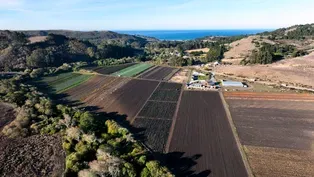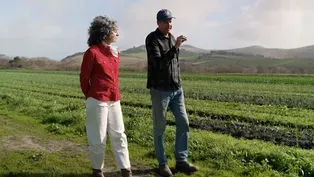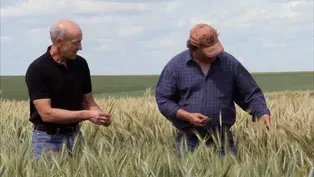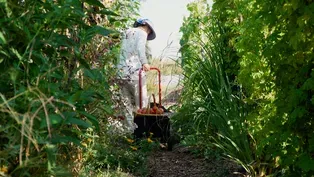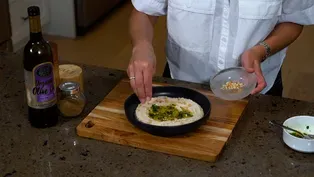
Episode 3
8/16/2024 | 26m 46sVideo has Closed Captions
Refugees grow and sell their own food, and a farmer diversifies his crops.
A farmer builds housing for his workers right on the land. Our health expert explains why farms that grow a diverse range of crops may be better for our health. Discover how to make a white bean dip appetizer. Visit a farm run by the International Rescue Committee that provides refugees a place to grow and sell their own vegetables. Meet farmers growing wheat in a very dry climate.
America's Heartland is presented by your local public television station.
Funding for America’s Heartland is provided by US Soy, Sustainable Agriculture Research and Education, Rural Development Partners, and a Specialty Crop Grant from the California Department of Food and Agriculture.

Episode 3
8/16/2024 | 26m 46sVideo has Closed Captions
A farmer builds housing for his workers right on the land. Our health expert explains why farms that grow a diverse range of crops may be better for our health. Discover how to make a white bean dip appetizer. Visit a farm run by the International Rescue Committee that provides refugees a place to grow and sell their own vegetables. Meet farmers growing wheat in a very dry climate.
How to Watch America's Heartland
America's Heartland is available to stream on pbs.org and the free PBS App, available on iPhone, Apple TV, Android TV, Android smartphones, Amazon Fire TV, Amazon Fire Tablet, Roku, Samsung Smart TV, and Vizio.
Providing Support for PBS.org
Learn Moreabout PBS online sponsorshipNarr: Coming up on America's Heartland.
Meet a farmer growing diverse vegetables by the Pacific coast, an expensive place to live.
That motivated him to build farm worker housing right on the land.
Ryan: I was struggling greatly with finding secure, stable labor, and having housing on site has allowed me to... to really stabilize that.
Narr: Our health expert Dr. Daphne Miller, also visits the farm and explains why farms that grow diverse vegetables may actually be better for your health.
We'll visit a farm run by the International Rescue Committee, or IRC.
The organization provides refugees a place to grow their own vegetables and sell them for a profit at a farmer's market.
Tynya: When they have a little money, they can relax and they can put their energy into learning the language, put their energy in learning the culture, and not have to worry about surviving.
Narr: And on Farm to Fork, our host Sharon Profis shows us how to make a simple but elegant dip made with white kidney beans.
It's an easy and tasty twist on hummus.
Plus a look at the challenges faced by farmers who grow wheat in places with little to no rainfall in the spring and summer.
It's all coming up next on America's Heartland.
Annc: America's Heartland is made possible by.
♪♪♪ ♪ You can see it in the eyes ♪ ♪ of every woman and man in America█s ♪ ♪ Heartland living close to the land.
♪ ♪ There's a love for the country ♪ ♪ and a pride in the brand ♪ ♪ in America's Heartland ♪ ♪ Living close... Close to the land ♪ ♪♪♪ ♪♪♪ Ryan: I don't know that when I started here, I thought I would never own a piece of property out here on the coast.
Narr: Transformation seems to be a common theme in Ryan Casey's life.
He didn't come from a farm family.
When he started college.
He was actually thinking about a career in environmental sciences.
But then Ryan took a couple of ag classes and after college, worked on a few farms and gardens.
That's when his life path was transformed, and his passion for working the land fully realized.
Ryan: My best advice is to go work for somebody, who's really good at what they do.
Go find a farmer and work for that person and... and learn as much as you can from somebody who's... who's been through the good, bad and the ugly and know what you're getting yourself into.
Narr: In 2016, what Ryan ended up getting into was a chance to lease some 80 acres of rich farmland near the northern California coastal town of San Gregorio.
An astonishing variety of organic crops are grown here, from potatoes to cabbage, onions, tomatoes, carrots, peppers, herbs and much more.
It's sold at nearby farmers markets, but visitors can also shop each weekend right here at the new Barn and Farm Stand, built by Ryan and his friends.
All that's part of what you might call a second transformation for Ryan.
This was a multi-generational family farm that, frankly, had seen better days.
It may have looked all right at first glance and perhaps from a distance.
Ryan: And then we start looking close up, you realize there's actually quite a quite a lot of work that needs to go into getting the infrastructure where it needs to be, to support a farm again.
Narr: Restoring this farm's infrastructure took years of hard work, but today there's a vastly improved irrigation system.
The farm draws water from a nearby riparian creek during the wetter winter months, and only uses water from the newly restored pond during the summer that protects the creek's ecosystem.
The farm also has a new packing shed, new greenhouses where herbs are grown and harvested, and perhaps most important, new farm worker housing, including four three bedroom mobile home units, a domestic well and a new septic system.
In a region where housing is both scarce and expensive.
Yolanda Guzman says these lower rent units have been a life saver for her fellow farm employees.
[Yolanda speaks spanish] - I just hope that it keeps growing and growing and hopefully we can have more housing for more workers.
It's very important because consumers can enjoy all the products, all the vegetables.
There's food on the table every day.
Ryan: I was struggling greatly with finding, secure, stable labor.
And having housing on site has allowed me to... to really stabilize that, to attract really great people.
Narr: Ryan is quick to credit others for his farm success, especially an organization called POST.
The Peninsula Open Space Trust, a nonprofit dedicated to preserving and restoring open space, forests, parks and farmland in this part of Northern California.
They bought this farm and leased it to Ryan, and early in 2024 sold it to him outright.
Ryan: I'm extremely thankful for POST.
I, uh, don't think that I would be farming out here on this coast if it wasn't for their support.
Daniel: Farms should be owned by farmers, we believe that.
It's incredible to be able to see, uh, a farmer who started on our property be able to take on ownership of this farm and know that it's going to be in good hands for generations to come.
Narr: There are major efforts underway across America to find, train and encourage the next generation of farmers.
Experts agree programs that preserve farmland and help farmers like this one and many others, will ensure that most of our nation's future food needs will be met right here at home.
Ryan: It just feels great.
It feels great to be stable and to know that I'm not going anywhere and I can invest in where I'm at.
♪♪♪ Daphne: So here we are at blue House farms, and when I look over these beautiful fields, I see a crazy quilt much like the ones that my grandmother used to make.
There are so many vegetables being grown in this acreage, and this is what you would call a diversified farming operation.
There are real benefits to having so many different kinds of fruits and vegetables growing together, because they each contribute different kinds of nutrients to the soil and maintain a healthy soil.
You always have roots in the ground and have the soil covered so that it doesn't get washed away or eroded.
And of course, it's lots of different kinds of income from this farm.
When one crop is being harvested, then that can sell and then a couple weeks later you have another crop to sell at market.
So financially, it makes a lot of sense to have all of this diversity on one farm.
But as a family doctor, I was wondering what are the nutrient benefits of eating plants from a diversified farm as compared to maybe a farm that just grows carrots or just grows celery?
And I did some research and found out that growing a variety of plants together is a win for all the different plants, and a win for our health.
So how does eating plants from a farm that produces such diversity improve our health and nutrition?
Plants work together.
The classic example being the Three Sisters, a system of planting invented by indigenous farmers of the Americas.
Corn serves as a trellis for the climbing beans.
The beans, in turn, put vital nutrients such as nitrogen back into the soil, and the big leaves of squash or pumpkin vines act as living mulch.
They hold water and they█re natural weed control.
What about the nutrients of the plants themselves?
This is a hard thing to study, but some studies suggest that plants grown in a diversified system have a higher amount of minerals than ones that are growing as part of a large monoculture.
This is because the richness of the soil.
What is the advantage, to you as a farmer in having such a diversified system here with so many different vegetables growing?
Ryan: Yeah, I treat the farm like a... like I would treat like a big backyard garden that I'd have for my home, or I'd want to go out and I want to pick a bunch of different stuff.
When you grow the same crop over and over again, it uses the same nutrients and macronutrients from the soil, so you're constantly removing those same things over and over again depleting your soil of certain things.
When you... when you rotate your crops, you are pulling different things as the different crops come and go.
And you're also giving more back to the soil.
Um, some crops actually give different things back to the soil.
If you aren't deeply in the soil of the same things over and over again, you're going to have richer soil and a more balanced soil, and a more balanced soil is going to mean a more balanced vegetable that you're pulling out of it.
There's also advantages with pests and disease control.
In that when you are growing different crops, you are breaking pests and disease cycles so that they don't build too much.
Daphne: Diversified farmers like Ryan are trying to maintain diversity in the field, but they're also doing it next to the field.
When I look around here, Ryan is not getting rid of the weeds, and that's for a very good reason.
First of all, that would require a lot of herbicides and pesticides that are not good for our health and that you can't use in organic farming.
But also these weeds serve a wonderful purpose in the wet season.
They draw a lot of moisture away from the crops, preventing rot from occurring and destroying the crops themselves.
Ryan: It also is habitat.
It's habitat for beneficial insects that need a place to overwinter.
So that when we're growing in the... in the growing season, those beneficial insects are already established as a population that can then move into the field and balance stuff out.
Daphne: So today we learned how diversity above ground and below ground is good medicine.
Is good for the soil, it's good for the farmer, and it's good for us.
♪♪♪ Narr: Still ahead on America's heartland, how to make a delicious bean dip recipe made with ingredients you probably already have in your pantry.
We'll also take a look at the challenges of wheat growers in regions of the country with very limited rainfall, and how they are reducing dangerous dust.
But first, meet refugees who are growing and selling vegetables at a farmer's market, helping them make a fresh start in a new country.
♪♪♪ Liang: My name is Liang Ma.
I am a farmer here.
Narr: Liang Ma seems proud of the sheer variety of crops he and his wife grow.
I grow many kind of vegetables such as strawberry, tomatoes, cucumbers, eggplants, luffa radishes, beans.
broccoli beans, corn, peanuts, sweet potatoes, yam, taro, watermelon, bitter melon, garlic, green onion, a lot.
Narr: He wants to make it clear his wife is the real farmer of the family.
But she's out of town today.
Or else she'd be doing the talking.
But he's happy to share the importance of the International Rescue Committee.
New Roots Farm near downtown Sacramento, California.
Liang: Like many people, when I started living in the U.S., I do not have a job to do.
Language... English language is barriers.
Narr: Liang now has a full time job, but during the growing season, weekends and evenings are spent tending to their plot.
The farm is operated by the International Rescue Committee, a global nonprofit organization founded in the 1930s providing life saving services to immigrants and refugees and people in crisis torn countries.
In this region, the need is clear.
From 2010, to 2020, 9% of refugees arriving in the United States resettled in California, many of them here in the Sacramento area.
There are often support programs available, but for many, the connection to growing food is vital.
Ram Khatiwada, Urban Roots founder, farm manager and himself a refugee, explains why.
Ram: The core problem for humanity is these people get displaced and there are millions and million people struggling to save their life and find a good home where they can survive.
They can gain their life, they can grow, have their families, they can have their freedom, they can have their rights, and they can have their own choices how to live, practice their culture and practice their recipes and language.
Narr: The program offers an opportunity to grow produce and learn farming techniques like nutrient and pest management.
Farmers can also sell their goods at the weekend farm stand.
Liang Ma█s strawberries are a top seller.
Ram: These are actually a place where you can find the food that is grown and eaten by different part of the world.
For example, if I have people from ten different countries, you are lucky to see ten different varieties of crops here that is culturally appropriate and that they are used to in their, country, in their recipes.
They come here and learn, they grow food, they take food to home.
So they of course save the money.
They sell the produce here.
And then we keep about 15% of the cost for our packaging, handling resources.
And all of that.
Raise about 85% of the money goes to them.
Narr: Tynya Beverly is the Leader of the Black and Brown Farm Collective, an organization that shares space here working with the refugees and immigrants.
Tynya: In order for people to be able to learn a new language or learn a new culture, they have to have a secure foundation.
So this farm provides economic development is one piece of their plan.
There's case management.
I mean, they're learning all this stuff, but when you do that, then they can relax when they have a little money, they can relax and they can, you know, put their energy into learning the language, put their energy in learning the culture and not have to worry about surviving.
Narr: That piece of mind is vital for Bhutanese refugee, Tek Chamligi.
He's getting a lesson today from Ram about the importance of using crop waste to replenish soil nutrients Tek: On the refugee camp, uh, we don't have land, so we have a small tent.
We keep it, stay in, small tent and, uh, a lot of, uh, trouble over there because if the wind coming, sometimes we, uh, uh... the tent to blow up so much, terrible thing over there, but right here, better.
Ram: Once you pull the person from drowning stage when you bring it out, support is -- should not be limited to that.
After that, the person has to live and eat and grow and thrive.
For that, we need support.
And here that is possible under New Root by providing, gardening land, small plot of land for families to grow food so they can have their choice of growing their produce there, they always like to have.
They miss it for a long time, because they have to run away from their country and their geography and their, their... their, uh, local areas.
Tynya: When you bridge a gap like that, all of a sudden you're in someone's heart space.
Something happens when you you can give someone food without attachment and no expectations, and you keep showing up and you're consistent in your community.
You change lives.
♪♪ Sharon: One of the more classic ways to use beans is by making a hummus.
And today we're going to riff on that by making a white bean dip that doesn't use chickpeas and instead uses another very humble bean, the cannellini bean, also known as a white kidney bean.
For this recipe, you only need a few simple ingredients and a food processor.
So let's make it happen.
We'll put one can of cannellini beans into the food processor.
Whenever you're using canned beans, they of course, come packed in a liquid that includes some salt.
So I already went ahead and rinsed these beans for this recipe.
You can also use dried beans and soak them overnight, and then cook them before making this recipe.
Into the food processor, I'm adding four tablespoons of pine nuts.
This is five, so I'm going to save one tablespoon for finishing the recipe later.
Now we will also add two minced or microplaned garlic cloves.
Then we'll add half a teaspoon of cumin.
This gives it a nice smoky flavor just a little bit.
And the zest of and the juice of one whole lemon.
Now the lemon is important here because it adds that acid that will need to balance out the very buttery flavor of the beans.
And the other important thing about the lemon that it does is it also increases the shelf life of this dish.
And then the last reason we need lemon is that it is a liquid that helps this turn into a dip.
We'll also add a couple tablespoons of olive oil, half a teaspoon of salt, and a few grinds of pepper.
Let's put this on top and take it for a spin.
We want this to be nice and smooth.
It should be dippable with either crackers or some veggies.
But let's also taste it.
Mmmm... almost perfect.
A little more salt.
[Food processor grinds] If you find that it's too thick and your food processor is struggling to blend it, one thing you can do is just add a little bit of water, maybe a tablespoon at a time until it gets the consistency you want.
But as you can see here, we're at the exact right consistency.
So I'm going to transfer this to a bowl.
And then we'll finish it up.
Our white bean dip is almost ready to be served.
But first we're going to make a spicy garlic oil.
Here's how you do it.
Heat two tablespoons of olive oil over medium heat.
Then add two minced garlic cloves and one teaspoon of chili flakes.
Let that sizzle for about a minute, being careful not to brown the garlic.
The hot oil will keep cooking it even when the heat turns off.
Take it off the heat and add a tablespoon of minced partially zest of one lemon and a pinch of salt.
That's it.
The spicy garlic oil is a perfect topping to this bean dip, but is also lovely with a fresh baguette.
Now we'll just spoon a little bit of this garlic oil right on top.
Look how pretty that is.
Like this dish was not done until this came along.
Right on top.
Those extra pine nuts that we saved.
Beautiful.
Just a handful of ingredients and maybe 15 minutes.
And you have your own homemade white bean dip.
Now, all that's left to do is eat.
♪♪ ♪♪ Narr: This vast landscape of gray skies and steady winds may suggest a place blessed by abundant rain.
But this cloudy June day in eastern Washington is misleading.
Farmer Ron Jirava, whose family's been working this land since 1884, says each season they plant and pray the heavens will provide enough moisture to sustain their winter wheat.
Ron: It comes only in the winter.
it's not reliable as far as how much we're going to get each winter.
But a lot of these crops, like some moisture in the spring, and it's been known to stop raining and any kind of precipitation from February on.
It makes it kind of difficult.
Narr: With rainfall so scarce, the prospect of a disappointing harvest and financial distress has always been part of life for these dry land farmers.
But in 1915, Washington State University began researching ways to coax more abundance from this parched and dusty soil.
It created the Dry land research station, laboratories, machine shops for new farm inventions, and more than 1300 acres of land for experimental planting.
Bill: I like being able to think I'm doing something useful.
Narr: Bill Schillinger is a scientist, professor, and the director of the station.
Bill: Are we operating in isolation?
In a way, yes, because no one else has such unique environments.
We're in our winter rainfall region with dry summers.
The circle I work in is, first, let's keep the soil from blowing.
So we need conservation, soil management, Narr: Preventing erosion, and conserving precious topsoil does more than help farmers grow bigger crops.
As Bill showed me, it keeps the air cleaner for the rest of us.
Bill: You know, take a stable clod.
It doesn't take much to pulverize it.
And then when you pulverize it and it goes in the air.
Narr: Nothing but dust.
Bill: And, the stuff you can't see is still in the air.
Whenever there's a dust storm, whenever there's an exceedance of the federal air standard, it's always, always associated with high wind events and blowing dust from agricultural fields.
And so researchers and wheat growers fess up.
So that's what we really want to stop.
In the past, farmers here grew only winter wheat planted in the fall, harvested in the summer.
That meant fields lying bare or fallow, often for months.
With dryland research help, farmers are trying new crop rotations to reduce dangerous dust, and they're assisting with test plots like these around Jirava█s farm.
This all in addition to no-till farming, where crop residue from the last harvest is left on the ground.
Wheat is nearly a $1 billion industry in Washington, its third biggest crop behind apples and dairy products, and up to 90% of Washington wheat growers are completely dependent on rainfall.
For Bill and his team, it's a big responsibility improving crops and air quality.
But the payoff is work that not only sustains vital production but ultimately keeps prices down on a vast array of consumer products.
Bill: It sounds corny, but I really am passionate about my job, and it's great to get paid to do what I'm passionate about.
We work with progressive farmers who feel the same way and are leading the pack, and that's how we're going to make it happen.
Narr: In an average year, American farmers raise more than 2 billion bushels of wheat.
The grain is grown in 42 states across the country on nearly 63 million acres of land.
Wheat is critical as a food resource.
One bushel of wheat can make more than 75 1 pound loaves of bread.
And did you know that more food is made from wheat than any other cereal grain?
You'll find wheat in breakfast cereals, pasta, pizza, tortillas, and other foods that depend on flour like your birthday cake.
Annc: That's it for this edition of America's Heartland.
That's it for this edition of America's Heartland.
For more stories, full episodes and recipes, visit AmericasHeartland.Org , or connect with us on Facebook.
♪ You can see it in the eyes ♪ ♪ of every woman and man in America█s ♪ ♪ Heartland living close to the land.
♪ ♪ There's a love for the country ♪ ♪ and a pride in the brand ♪ and a pride in the brand ♪ in America's Heartland ♪ ♪ Living close... Close to the land ♪ Annc: America's heartland is made possible by: ♪♪
Video has Closed Captions
A farmer builds housing for his workers right on the land. (4m 24s)
Diversified Farms – Harvesting Health
Video has Closed Captions
Our health expert explains why farms that grow a diverse range of crops may be better for our health (4m 39s)
Video has Closed Captions
Meet farmers growing wheat in a very dry climate. (4m 35s)
Growing Opportunities for Refugees
Video has Closed Captions
Visit a farm run by the International Rescue Committee that provides refugees a place to grow. (5m 33s)
White Bean Dip – Farm to Fork with Sharon Profis
Video has Closed Captions
Discover how to make a white bean dip appetizer. (4m 1s)
Providing Support for PBS.org
Learn Moreabout PBS online sponsorshipAmerica's Heartland is presented by your local public television station.
Funding for America’s Heartland is provided by US Soy, Sustainable Agriculture Research and Education, Rural Development Partners, and a Specialty Crop Grant from the California Department of Food and Agriculture.
